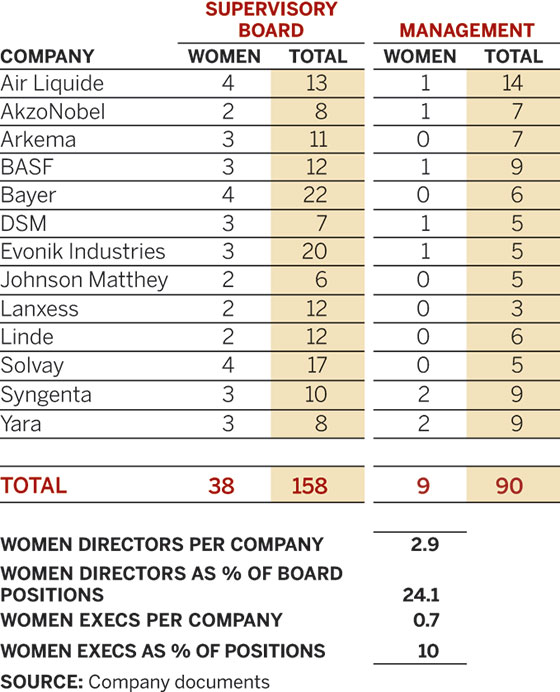Advertisement
Grab your lab coat. Let's get started
Welcome!
Welcome!
Create an account below to get 6 C&EN articles per month, receive newsletters and more - all free.
It seems this is your first time logging in online. Please enter the following information to continue.
As an ACS member you automatically get access to this site. All we need is few more details to create your reading experience.
Not you? Sign in with a different account.
Not you? Sign in with a different account.
ERROR 1
ERROR 1
ERROR 2
ERROR 2
ERROR 2
ERROR 2
ERROR 2
Password and Confirm password must match.
If you have an ACS member number, please enter it here so we can link this account to your membership. (optional)
ERROR 2
ACS values your privacy. By submitting your information, you are gaining access to C&EN and subscribing to our weekly newsletter. We use the information you provide to make your reading experience better, and we will never sell your data to third party members.
Business
Women in industry 2016
Another year brings more gains in C&EN’s annual survey of women serving at the top of the chemical industry ladder
by Alexander H. Tullo
August 29, 2016
| A version of this story appeared in
Volume 94, Issue 34

Women continue to make modest gains in the chemical industry.
Sources: Company documents

Sources: Company documents
Note: Data based on firms listed on pages 23 and 24.

Note: Data based on firms listed on pages 23 and 24.
Women occupy 16.7% of 430 board of director seats at 42 U.S. firms with large chemical businesses, according to C&EN’s latest annual survey. This is an increase from the 16.2% posted a year ago. Similarly, on average, 1.7 women serve on each chemical company board, versus 1.6 in 2015.
Women have made greater strides in the executive suite, according to the survey. They occupy 14.2% of the 402 executive officer positions at the 42 companies. In 2015, the same firms held 13.4% of such positions.
To compile the survey, C&EN consults annual company reports as well as proxy statements and 10-K annual report forms filed with the Securities & Exchange Commission by publicly traded U.S. companies that have significant chemical businesses.
Because chemical firms don’t often modify their boards or top management, the numbers move slowly. But over time, change accumulates. A decade ago, C&EN’s survey put the proportion of women serving on chemical boards and in executive suites at 11.1% and 8.8%, respectively.
Still, the chemical industry is behind the rest of the corporate world. Catalyst, a New York City-based organization dedicated to the advancement of women in the workplace, released a survey in June of the corporate boards of companies that make up the Standard & Poor’s 500 stock index. It found that women occupy 19.9% of the board seats at these firms.
In the survey, Catalyst also found that 9.5% of the top earners at S&P 500 firms are women. This category lists those executives whose salaries are published in companies’ proxy statements. It is not a perfect comparison with C&EN’s survey because it tends to be a narrower category.
For the second year, C&EN surveyed 13 large European chemical firms, finding that 28.6% of the 154 board seats are filled by women. Of the top executives at these firms, 10% are women.
This comparison to the U.S. survey isn’t apples to apples. German companies tend to have union representation on their boards, which can be a source of female inclusion. On the other hand, European firms typically list fewer top executives in their annual reports—just the chief executive, financial officers and a couple others. This exclusive group is less likely to include women than the broader U.S. executive officer category.

Source: C&EN
Below the survey results, C&EN profiles three women who have established rewarding mid-level careers in the chemical enterprise. Although the three have different roles, they all emphasize opportunity in describing factors critical to their success. And all three capitalize on opportunity when it’s presented to them.

Three women in industry: C&EN takes a look at executives who climbed the ladder by seizing opportunity at every rung
Anca Rusu
▸ Project director, Pennsylvania chemicals project
▸ Royal Dutch Shell
In June, Royal Dutch Shell gave the green light to building a massive petrochemical plant in Monaca, Pa. As the oil and chemical firm’s largest North American project, the multi-billion-dollar investment will feature a new ethylene cracker and downstream polyethylene plants. It is currently the most well-developed large chemical project outside of the U.S. Gulf Coast meant to tap into low-cost U.S. shale gas.
Anca Rusu is responsible for its construction. She has been involved with the planning since 2013, seeing it from front-end engineering and design through the final investment decision by Shell’s board. She is currently working on preparing the site, which sits on the Ohio River not far from Pittsburgh. Construction will begin in earnest early next year. When activity peaks in 2018, she will lead a workforce of 6,000 people.
“From the perspective of authority and accountability, this position is the highest I have had so far,” Rusu says.
As a child, Rusu was inspired to become an engineer by listening to her father and uncle talk shop. Her father was a metallurgical engineer with an international reputation for commissioning facilities and solving tricky problems. Her uncle was a professor of chemical engineering in her native Bucharest, Romania. Hearing them fascinated and inspired Rusu. She wanted to equal or surpass what they had accomplished.
She earned a double degree in mechanical and electrical engineering from University Politehnica of Bucharest in 1989. She managed a benzene plant in Romania for a few years. From there she headed to Canada, where she worked for the engineering firms Stone & Webster and WorleyParsons and completed her MBA at York University.
She joined Shell in 2005, participating in front-end engineering for projects in Russia, India, Iran, and Algeria. She had a key role in Shell’s Antar gas exploration project in the United Arab Emirates.
By far, Rusu’s largest project was Phase II of Shell’s Kashagan offshore oil project in the Caspian Sea off the coast of Kazakhstan. For that project, she led a 600-person design team in London for three years.
“That’s one of the greatest things about Shell,” she says. “You get all sorts of big opportunities.” Rusu credits her own success to determination, commitment, optimism, and luck. “Luck to come across great people who believe in you and give you chances and push you and coach you and guide you,” she says.
Rusu is trying to be that person for others at Shell. As a mentor to eight young men and women, she confronts some of the reasons why the oil and chemical industries can struggle to attract and retain talent. They are traditional industries, and younger people think they can cultivate their talents better at start-ups. Rusu tries to convince them that oil and chemistry are still innovative fields and that they offer opportunity—as they have for her—to do big things.
Mara Gliozzi
▸ Global business manager for specialty chemicals
▸ McGean
Cleveland-based McGean is one of the many niche chemical firms that fill the gaps between giants such as BASF, Dow Chemical, and Eastman Chemical by filling orders and earning profits in small-volume chemicals that the big firms don’t trouble themselves with.
The 100-employee strong company makes Cee-Bee brand formulated products for aircraft maintenance—things such as lavatory cleaners and paint strippers. Long-time employee Mara Gliozzi observes that the company provides most every chemical used on an aircraft but the “deicers, paints, and fuels.”
Gliozzi runs McGean’s specialty chemical business, which has manufacturing operations in Cleveland; Livonia, Mich.; and Wolverhampton, England. The company markets its own line of specialty chemicals and runs a custom manufacturing business.
McGean’s chemicals business performs inorganic and organic synthesis, working with intermediates such as allyl chloride, benzyl chloride, and epichlorohydrin. The firm has special expertise in handling chromium compounds, such as trivalent chromium intermediates.
Gliozzi has been with McGean for 32 years. The company provided her first job out of high school and she stayed with it part-time while studying marketing and business administration at Cleveland State University. She remained part-time while her children were young, working 20 to 30 hours a week in marketing and customer service. Gliozzi began climbing the ladder when she was able to work full-time and has headed the specialty chemical unit for the past eight years.
She credits McGean for her success. It gave her the opportunity to work part-time while she was educating herself and raising a family and has always been committed to work-life balance.
Gliozzi appreciates that McGean is a close-knit company. “The ability to know each other, know everyone’s names, their spouses’ and children’s names, makes it easier to be able to support each other,” she says.
Sherry Duff
▸ Vice president and chief marketing officer
▸ Innophos
Based in Cranbury, N.J., Innophos Holdings is one of the leading makers of phosphate chemicals. The company, once a part of the French giant Rhodia, offers phosphates for food, health, and industrial applications.
Innophos is looking to expand the pie and move further into adjacent food and nutritional markets after a string of small acquisitions in 2011–13.
Earlier this year, industry veteran Sherry Duff was brought in to help. She will lead a marketing organization, which, in the words of Chief Executive Officer Kim Ann Mink, will “dovetail with technology” to foster this transformation.
Duff was interested in chemistry from an early age. “What I enjoyed about chemistry was its ability to explain the world around us utilizing systematic scientific principles,” she recalls. She earned a bachelor’s degree in chemistry from the University of Connecticut in 1989.
Duff joined chemical, ammunition, and brass maker Olin as a chemist but soon became fascinated with the commercial purposes of her projects. “I was interested in understanding the business of chemistry,” she says.
Getting involved in technical service allowed her to “leap from the bench to the commercial world,” she says. While at Olin, Duff sealed her transformation with an MBA from Rensselaer Polytechnic Institute.
Duff climbed the ranks at Olin, working in its electronic materials, chlor-alkali, hydrazine, and biocides businesses. She found herself at Arch Chemicals when it was spun off from Olin in 1999.
Early on, Duff helped lead the diversification and growth of Arch’s personal care ingredients business, and from 2003 to 2006, she was the firm’s R&D director. When Swiss fine chemicals maker Lonza signed an agreement to purchase Arch in 2011, Duff was working in strategic planning and business development.
She left Arch before the deal closed to head Arista Laboratories, an analytical chemistry and toxicology lab business with expertise in smoke science. Parent company Molins sold the business last year, and Duff joined Innophos earlier this year.
To Duff, cultivating a pipeline of female chemistry leaders means encouraging girls to take an interest in science, technology, engineering, and mathematics as early as elementary school. Once women are in the workforce, she says, advancement “starts with opportunities.” Women who are successful are an example for colleagues who are earlier in their careers, Duff says.







Join the conversation
Contact the reporter
Submit a Letter to the Editor for publication
Engage with us on Twitter